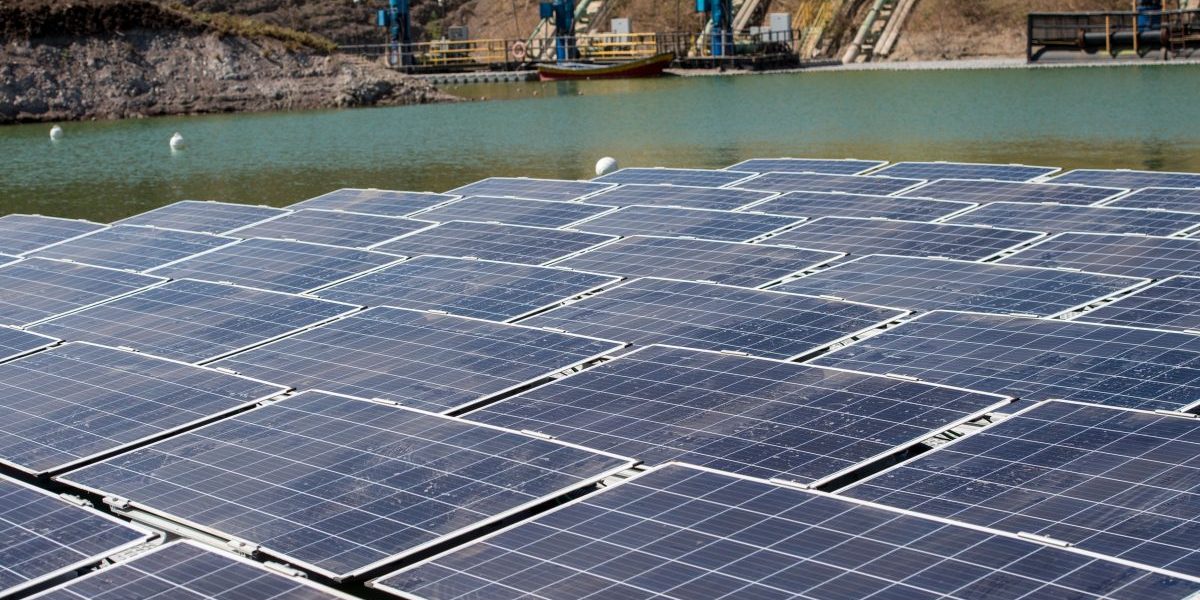Recommendations
- Renewable energy is lower cost than either grid or diesel power over a 20-year period and should be promoted as part of improving extraction efficiency in the minerals sector.
- Increased emphasis on the development of portable/mobile solar power systems is required to facilitate uptake in the minerals sector.
- Tertiary educational institutions should develop renewable energy-focused courses to provide the numbers of skilled technicians and engineers required to support the expansion of the renewable energy sector.
- Renewable energy systems for community and/or utility use should be considered as part of post-mining planning – these systems represent a way of generating sustainable benefits for communities from degraded land.
Executive summary
Energy costs represent a significant share of capital expenditure and operational expenditure for mining operations, particularly those positioned in locations where grid power is unavailable or unreliable. There is an increasingly strong case for the use of renewable energy in mining operations, particularly in hybrid systems that operate in combination with grid power or diesel generators. Renewable energy is now a viable way of diversifying energy supplies and reducing price volatility. As input energy requirements increase with decreasing mineral grade and commodity prices trend downwards, the need for energy innovation will be unavoidable. This, coupled with increased acceptance of novel technologies in the sector and renewable energy’s established role in reducing environmental impacts, will make renewable energy increasingly attractive.
Introduction
Arguments for a transition away from fossil fuels to renewable energy (RE) mostly pivot on the risks of carbon emissions. There are well-documented cases of large-scale RE projects in developed countries, but a widespread belief that current RE technologies are impractical for the mining and minerals sector1B. Fleet et al., ‘Prospects for Renewable Energy Systems in the Mining Industry, Maintenance, Engineering and Reliability,’ CIMJournal 6, no. 1 (2015): 27-34.persists.
Diesel generators are common on remote sites and this fuel is also used extensively for mobile plant. Diesel generators are better than solar photo-voltaic (PV) systems for managing power factor variations, grid frequency and inertia, and short circuit currents 2Thomas Hillig, ‘System Optimization of Renewable Energy Microgrids with Heat Recovery in Remote Mining’, THEnergy/Triogen Report, THEnergy Sustainable Consulting, www.th-energy.net (2020): 11.but only convert 40% of the energy in fuel to electricity. Most of the remainder is wasted as heat and noise. Diesel generator use is likely to incur carbon taxes. Under these circumstances, RE provides a possible solution: a study of carbon emissions from the Chilean copper mining industry showed that reductions of up to 60% could be achieved by replacing conventional energy sources with RE.3Jannik Haas et al., ‘Copper Mining: 100% Solar Electricity by 2030?’ Applied Energy 262 (2020): 11.
Energy’s contribution to mining capital expenditure (capex) is reportedly 25%.4Michel Carreau, ‘Hybrid Power at Remote Mining Sites to Reduce Electricity Costs’, Journal of the Canadian Institute of Mining, Metallurgy and Petroleum, (2013), 9. https://www.onemine.org/document/abstract.cfm?docid=213694&title=Renewable-Power-atRemote-Mining-Sites.It is seldom less than 10% and frequently exceeds 25% of operating expenditure5Sudeshna Ghosh Banerjee, et al., The Power of the Mine: A Transformative Opportunity for Sub-Saharan Africa. Directions in
Development (Washington, DC: World Bank 2015), 173.(opex). While overall RE costs have come down substantially since 2005, and PV systems dropped by 75% over the ten years to 20166Thomas Hillig, ‘Mobile Solar- and Wind Diesel Hybrid Solutions for Mineral Exploration’, Pfisterer/THEnergy Study, THEnergy Sustainable Consulting, www.th-energy.net, (2016): 14; Kateryna Zharan and Jan Bongaerts, ‘Decision-Making on the Integration
of Renewable Energy in the Mining Industry: A Case Studies Analysis, a Cost Analysis and a Swot Analysis’, Journal of Sustainable
Mining 16, (2017) 162-170., RE still has a high initial capex and requires 10-20 years before a lower total cost of ownership is achieved relative to traditional power sources.7Fleet et al., ‘Prospects for Renewable Energy Systems in the Mining Industry’, 27-34.The move to RE entails a shift from low capex/high opex to high capex/low opex. This may deter junior mining companies from adopting RE as they are often more sensitive to capital raising during construction than to higher opex once the mine is built. However, for remote mines on diesel generators the relatively lower RE operating cost insulates the mine from future fuel price increases.
Challenges
Supply versus demand on mine sites
Demand is relatively constant on most sites as mines commonly require a 24-hour supply of uninterrupted, baseload electricity. Solar and wind power are both influenced by location, temperature, altitude, season and time of day.8Fleet et al., ‘Prospects for Renewable Energy Systems in the Mining Industry’These energy sources are subject to intermittent production and consequently, stand-alone solar or wind systems are unsuitable for powering mines.9Roman Guenter Votteler and Alan Colin Brent, ‘A Literature Review on the Potential of Renewable Electricity Sources for Mining
Operations in South Africa’, Journal of Energy in Southern Africa 27, no. 2, (2016): 21.If rescheduling energy demand is impractical, the three options for employing RE at mines are: RE with storage, hybrid stand-alone or hybrid with storage.
RE project risks
As recently as 2013, many mining companies still viewed RE as ‘unproven technology’10Fleet et al., ‘Prospects for Renewable Energy Systems in the Mining Industry’.and it was seen as increasing investment risk.11Carreau, ‘Hybrid Power at Remote Mining Sites to Reduce Electricity Costs’.In many mining areas, RE service infrastructure is not fully developed and the technology is regarded as complicated with installation at remote sites compromised by skills shortages. Votteler and Brent identified overall system efficiency of RE as the principal technical risk for mining projects.12Roman Guenter Votteler and Alan Colin Brent, ‘A Mining Perspective on the Potential of Renewable Electricity Sources for Operations in South Africa: Part 1’, Journal of the Southern African Institute of Mining and Metallurgy 117, no. 3, (2017): 285-297.These authors also reported that social acceptability and job-creation were headline issues. At remote sites, especially in Africa, jobs are scarce and in great demand. RE construction projects offer little employment, most of which is highly skilled.13C. Chambers, “Off-Grid Solar in the Mining Sector – Can Renewable Energy Reduce your Operating Costs?” Proceedings:
Metallurgical Plant Design and Operating Strategies (MetPlant 2013 Conference, Perth, WA, July 15-17, 2013), 15.During operations, routine maintenance can be undertaken with limited staff numbers and with skills supplemented by remote monitoring. This does not help with job creation, potentially increasing local hostility to RE. Wind is reported to have a slightly lower job creation potential and slightly longer implementation period relative to solar for hybrid installations with similar performance characteristics.14Roman Guenter Votteler and Alan Colin Brent, ‘A Mining Perspective on the Potential of Renewable Electricity Sources for Operations in South Africa: Part 1. The Research Approach and Internal Evaluation Process’, Journal of the Southern African Institute of Mining and Metallurgy, 117, no. 3 (2017): 285–297
The case for RE
Hybrid systems
Low RE penetration in a hybrid system means that traditional power sources, such as diesel generators or the grid, carry most of the load. High penetration means that the RE system carries most or all of the load at certain times, with traditional power sources acting as a topup. In low penetration scenarios, RE variability is not problematic15Carreau, ‘Hybrid Power at Remote Mining Sites to Reduce Electricity Costs’.as the generator spinning reserves16Unused capacity available for supplying power during a shortage is the ‘spinning reserve’. To supply this emergency power, a diesel generator is run below its rated output so that it can quickly ramp up (David Wenzhong Gao, “Energy Storage for Sustainable Microgrid,” chap. 2 in Application of ESS in Renewable Energy Microgrids (Amsterdam: Elsevier, 2015): 35-77).absorb power variations. Diesel generators typically operate at 85% of capacity.
Because solar PV is subject to interference by cloud cover and wind is often changeable, power generation can be intermittent. At low penetration levels, the system can accommodate solar ramping, but at higher levels, storage systems are required to keep the system stable. Hybrid energy systems have facilitated greater RE penetration.17Jun Chen and Christian Rabiti, ‘Synthetic Wind Speed Scenarios Generation for Probabilistic Analysis of Hybrid Energy Systems’,
Energy 120, no. 207, (2017): 507-517.
Wind and solar hybrid systems
A number of factors influence RE system selection, but hybrid wind power is often favoured in higher latitudes and hybrid solar power elsewhere. Both of these can be grid-tied or stand-alone. Solar PV has the highest potential for use on mines in South Africa18Roman Guenter Votteler and Alan Colin Brent, ‘A Literature Review on the Potential of Renewable Electricity Sources for Mining Operations in South Africa’ Journal of Energy in South Africa 27, no. 2 (2016): 1-16.and while capex was approximately three times the traditional power sources (in 2016), they were low relative to other RE systems. Levelised costs were half those of diesel and approximately the same as grid.
The high cost of grid connections makes RE attractive. Grid supply costs may also be prohibitive: in South Africa, the cost of grid supply increased by 346% between 2007 and 2015.19Votteler and Brent, ‘A Literature Review’, 7.
Diesel is the dominant power source
Diesel currently dominates power supply at remote sites, but is expensive and likely to increase in cost. Diesel power is prevalent in many developing countries due to the unavailability or unreliability of grid power. Electricity outages can result in daily losses of millions of dollars. There are also time delays in restarting and ramping back up, as well as safety implications when supply is lost.20Chambers, “Off-Grid Solar in the Mining Sector – Can Renewable Energy Reduce your Operating Costs?”.In remote settings, the logistics of diesel supply can be daunting resulting in outages and degrading the economic case for diesel.
Solar PV can be used as a hedge to manage the price risk as most PV-related costs occur during construction. Overall costs decrease over the lifetime of the system because there are no fuel costs and low maintenance costs.21Thomas Hillig, ‘Solar Projects, Energy Efficiency and Load Shifting for an Optimized Energy Management in the Mining Industry’, Cronimet/THEnergy Study, THEnergy Sustainable Consulting, www.th-energy.net, (2015): 16.Diesel generators require low initial investment, limited space and are quickly installed, but operating costs are high and unpredictable due to fluctuations in fuel prices.22Votteler and Brent, ‘A Mining Perspective on the Potential of Renewable Electricity Sources for Operations in South Africa: Part 1’.Integrating diesel generators with PV in a hybrid system increases the initial capital investment, but significantly reduces costs over a 20-year life. This also reduces emissions. A capital-efficient approach may be to start operating with diesel generators and then to replace them as soon as the mine’s debt burden has been reduced with hybrid PV.
Energy storage and technology lifespan
Energy storage is key to matching intermittent RE generating capacity with constant demand. In some instances, savings may not come from reductions in diesel consumption but from increased operational efficiencies in the existing system through spinning reserves created by storage systems.23Jakob Janzen et al., “Battery Energy Storage as a Way to Reduce Remote Mine Electricity Costs” (Proceedings, World Mining Congress, Montreal, Quebec, August 11–15, 2013), 11.Use of energy storage allows diesel generators to run at higher power and with higher efficiency as it provides the spinning reserve. Use of large storage capacity also enables higher RE penetration. Energy storage has historically represented a significant capital outlay but costs are falling.
Wind and solar systems have historically been designed for permanent installation, which is problematic in isolated locations when their lifespan exceeds that of the mine. PV is modular, so a site could start with a small installation and increase in size as batteries become economically viable.24Chambers, “Off-Grid Solar in the Mining Sector – Can Renewable Energy Reduce your Operating Costs?”This approach is facilitated by the short construction times for PV systems.25Deutsche Gesellschaft fuer Internationale Zusammenarbeit, Subsector Analysis: Zambia – The Power Crisis and its Consequences
for Solar Energy in the Zambian Mining Sector, (Berlin: GIZ, 2016), 13.Due to optimised mounting systems, containerisation and high-efficiency PV panels, modern RE systems can be made portable and moved, even with exploration sites.26Thomas Hillig, ‘Modular, Semi-Portable Mounting Systems for Solar in the Mining Sector’, Nuance Energy/THEnergy Study, THEnergy Sustainable Consulting, www.th-energy.net, (2018): 12.This is an important breakthrough as the high initial capex generally makes RE only affordable over longer time periods.
The future
In EY’s Top 10 Business Risks and Opportunities 2020 survey, obtaining a social licence to operate was the top ranked risk and reducing the operation’s carbon footprint was ranked fourth.27Paul Mitchell, ‘Top 10 Business Risks and Opportunities – 2020,’ EY, September 24, 2019, https://www.ey.com/en_gl/mining-metals/10-business-risks-facing-mining-and-metals.
Mining Review Africa’s 2019 survey found that 43% of responding mining companies would use RE if it reduced costs; 35% if it reduced grid reliance and 27% to decrease environmental impact.28Gerard Peter, ‘Why Renewable Energy Makes Sense for Mining,’ Mining Review Africa, September 26, 2019, https://www.miningreview.com/energy/why-renewable-energy-makes-economic-sense-to-mining/.In this briefing, several citations have been provided in support of the steep and sustained decrease in the levelised costs of RE-generated electricity. Increasingly efficient and affordable batteries will reinforce this.29‘Top 5 Energy Trends of 2019,’ Power, October 27, 2019, https://www.powermag.com/top-5-energy-storage-trends-of-the-year/.
The rise of electric vehicles (EVs) and the impending obsolescence of diesel trucks will enhance RE uptake. EVs are more efficient (long-haul electric trucks are 45% more efficient than diesel equivalents30Thomas Earl et al., ‘Analysis of Long Haul Battery Electric Trucks in EU: Marketplace and Technology, Economic, Environmental, and Policy Perspectives’, (Proceedings: 8th Commercial Vehicle Workshop, Graz, Austria, May 17-18 2018), 22.) and the pressure to convert to EV haulage will mount. Thus, more electricity will be required on site and more RE generating capacity will be installed.
Combining wind and solar power is a trend likely to increase RE utility on mines. Hillig reports increasing use of both solar and wind31Renewable Energy and Mining, THEnergy, https://www.th-energy.net/english/platform-renewable-energy-and-mining/.. Although both are unstable they are often negatively correlated: whereas use of both wind and solar power jointly levels out the generation profile and reduces the required spinning reserve.
In South Africa, mines are moving away from grid dependence. Anglo American has made an application to the government to self-generate 75 MW of solar power at Mogalakwena Platinum Mine, and Gold Fields’ South Deep Mine has applied for permission to generate 40 MW of solar power.32‘Details of Mantashe’s Mining Power Generation Concession Still Missing,’ Mining Review, March 3, 2020, https://www.miningreview.com/energy/details-of-mantashes-mining-power-generation-concession-still-missing/.The Minerals Council SA reported that the industry has 1.5 GW energy projects in the pipeline. This trend is not restricted to countries that already have exposure to RE, for example, India is targeting 100 GW of solar PV by 2022.33Fitch Solutions, ‘Shift to Renewables to Become a Growing Trend in Mining’ https://www.fitchsolutions.com/corporates/metalsmining/shift-renewables-become-growing-trend-mining-31-08-2018.
Conclusion
RE has moved from being a niche power source for small, remote mine sites to one of the lowest-cost energy sources for large-scale mines, even when they are already grid connected. RE is now a viable way of diversifying energy supplies and reducing price volatility. As input energy requirements increase with decreasing mineral grade and commodity prices trend downwards, the need for energy innovation will be unavoidable. This, coupled with increased acceptance of novel technologies in the sector and RE’s established role in reducing environmental impacts, will make RE increasingly attractive. RE’s potential to drive down energy costs in the long-term appears to be established. Mining companies will be able to claim a leadership position in many countries as they transition to new energy sources.
A caveat is that the energy density of the dominant forms of RE, PV and wind is low. Large land areas will be required to completely replace traditional power sources. Post-mining land will need to be used for RE generation and energy efficiencies in mining and mineral processing will need to improve.
Acknowledgement
SAIIA gratefully acknowledges the support of the Swedish International Development Cooperation Agency (SIDA) for this publication.







